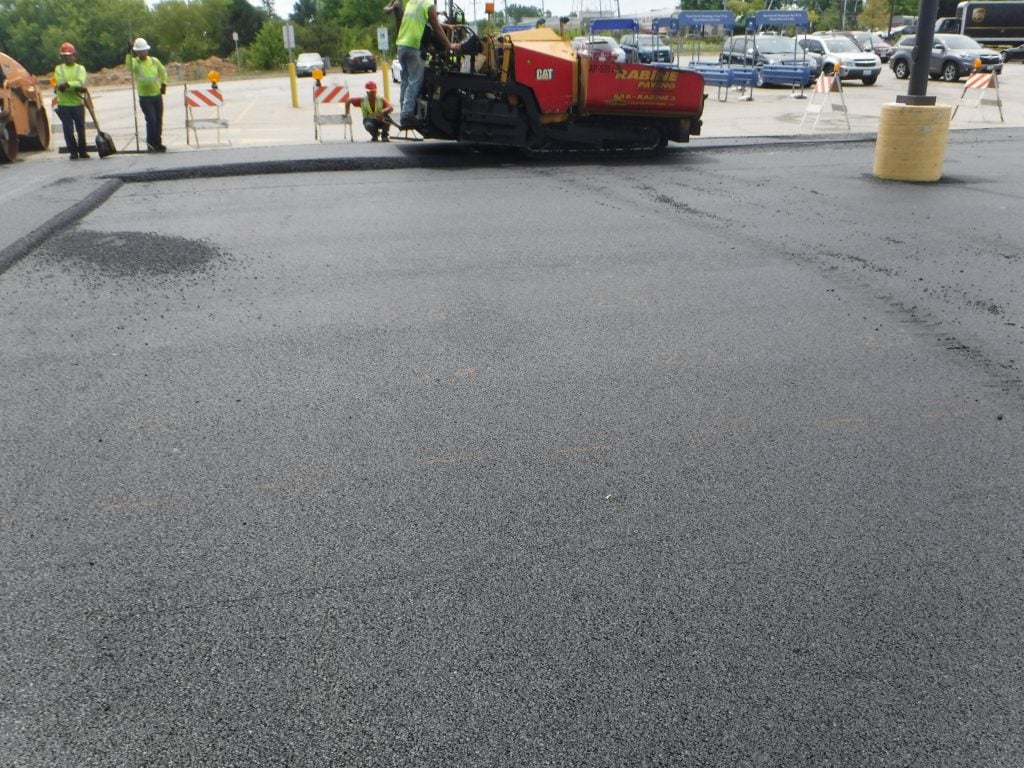Hot Mix Asphalt Paving: The Secret to Smooth, Angled Parking Lot Surfaces
Hot Mix Asphalt Paving: The Secret to Smooth, Angled Parking Lot Surfaces
Blog Article
Checking Out the Environmental Benefits of Hot Mix Asphalt
The utilization of Warm Mix Asphalt in facilities jobs presents an engaging instance for sustainable development and ecological stewardship. By diving into the elaborate information of its manufacturing procedures and the innovative use recycled products, a deeper understanding emerges of how this technology exceeds simple surface area applications. The ecological benefits of Warm Mix Asphalt prolong far past preliminary impressions, offering a nuanced point of view on how this product can pave the way for a greener future.

Minimized Greenhouse Gas Emissions
Warm Mix Asphalt production provides a significant decrease in greenhouse gas emissions compared to other pavement materials. The manufacturing procedure of Warm Mix Asphalt involves heating the blend of aggregate and asphalt binder to heats. This process requires less energy compared to the production of alternate pavement materials, leading to lower greenhouse gas discharges. Furthermore, the usage of recycled products in Hot Mix Asphalt additionally adds to lowering its ecological influence. By including redeemed asphalt sidewalk and recycled asphalt roof shingles into the mix, the requirement for virgin materials is reduced, resulting in energy savings and decreased emissions related to removal and handling.
Studies have shown that Hot Mix Asphalt sidewalks have a smaller carbon footprint over their life process compared to various other sidewalk options. The toughness and recyclability of Hot Mix Asphalt further improve its environmental advantages by minimizing the need for constant maintenance or replacement, therefore saving sources and lessening emissions related to repair activities.
Power Effectiveness and Conservation
The manufacturing process of Warm Mix Asphalt not only lowers greenhouse gas discharges yet likewise adds dramatically to power efficiency and preservation efforts. Energy performance is an essential benefit of Hot Mix Asphalt manufacturing compared to other sidewalk types. The procedure involves heating up the products at high temperatures to develop the asphalt mix, which needs much less energy than alternate methods. Furthermore, the capacity to recycle and recycle asphalt pavement additionally enhances energy preservation. By incorporating redeemed asphalt pavement (RAP) right into brand-new mixes, the market conserves energy that would certainly have been needed to create entirely new products. Moreover, the longevity of Hot Mix Asphalt minimizes the regularity of maintenance and restoration, bring about long-term energy cost savings. This long life minimizes the energy-intensive procedures associated with constant repairs and replacements. In General, Hot Mix Asphalt attracts attention as an eco-friendly choice that focuses on power efficiency and conservation throughout its lifecycle.
Lasting Sidewalk Solutions

One secret element of lasting pavement remedies is the usage of recycled materials such as reclaimed asphalt sidewalk (RAP) and recycled try here asphalt roof shingles (RAS) By including these materials into the asphalt blends, the need for virgin sources is minimized, resulting in reduced energy consumption and greenhouse gas discharges throughout production. In addition, the reuse of these materials helps divert waste from landfills, contributing to an extra lasting and round economic climate.
Moreover, lasting sidewalk options concentrate on maximizing pavement design to boost efficiency and longevity. Methods such as cozy mix asphalt (WMA) and rock mastic asphalt (SMA) improve the resilience and resilience of pavements, minimizing the demand for regular repair services and substitutes. By executing these innovative techniques, infrastructure programmers can develop sidewalks that not only fulfill high-performance requirements however also minimize their environmental impact.
Minimized Environmental Influence
Hot mix asphalt, in particular, provides several benefits that add to lowering the general ecological impact of roadway infrastructure. One key aspect is the recyclability of asphalt, which can be reused multiple times without compromising its top quality - Regrading.
Furthermore, the manufacturing of warm mix asphalt sends out lower degrees of greenhouse gases contrasted to various other pavement materials, making it a much more eco friendly option. The energy performance of asphalt plants has actually also enhanced throughout the years, resulting in decreased fuel intake and reduced exhausts. Furthermore, the smooth surface of warm mix asphalt decreases rolling resistance for cars, leading to reduced look at this web-site fuel usage and reduced air contamination from lorry exhausts.
Contribution to Environment Change Mitigation
Warm mix asphalt plays a critical duty in mitigating environment modification via its sustainable residential properties and decreased environmental effect. One significant payment to climate adjustment mitigation comes from the power effectiveness of hot mix asphalt production. Contrasted to various other pavement options, the production process for warm mix asphalt takes in less power and discharges lower levels of greenhouse gases, thus minimizing its overall carbon impact.
Furthermore, warm mix asphalt's capacity to show sunshine, understood as albedo, aids in decreasing urban heat island impacts. By decreasing heat absorption and retention, hot mix asphalt pavements can reduce the need for air conditioning in urban areas, subsequently reducing greenhouse gas exhausts connected with energy usage for cooling purposes.
Additionally, the durability and recyclability of warm mix asphalt better enhance its climate adjustment reduction capabilities. Regrading. The lengthy life expectancy of asphalt sidewalks lowers the requirement for constant repair services or replacements, eventually reducing the carbon emissions connected to roadway maintenance activities. In addition, the recyclability of asphalt materials reduces the need for virgin sources and reduces the environmental influence of sidewalk building check over here and construction, straightening with sustainable practices for environment change mitigation.
Verdict
To conclude, the environmental benefits of Warm Mix Asphalt demonstrate its considerable payment to reducing greenhouse gas exhausts, saving power, and lessening ecological impact. This sustainable sidewalk service lines up with environment modification mitigation efforts, promotes resource preservation, and boosts facilities advancement. By utilizing recycled materials, energy-efficient production processes, and long lasting layout, Hot Mix Asphalt plays an essential function in promoting a more eco-friendly strategy to framework construction.
The manufacturing process of Warm Mix Asphalt entails heating the mix of aggregate and asphalt binder to high temperatures. By including recovered asphalt sidewalk and recycled asphalt shingles right into the mix, the demand for virgin products is minimized, leading to energy financial savings and lowered emissions associated with extraction and handling.
One secret element of lasting sidewalk services is the use of recycled materials such as redeemed asphalt sidewalk (RAP) and recycled asphalt roof shingles (RAS) Methods such as warm mix asphalt (WMA) and stone mastic asphalt (SMA) boost the longevity and durability of pavements, reducing the need for regular repair services and substitutes. Compared to various other sidewalk options, the manufacturing procedure for hot mix asphalt takes in much less power and releases lower degrees of greenhouse gases, therefore lowering its total carbon footprint.
Report this page